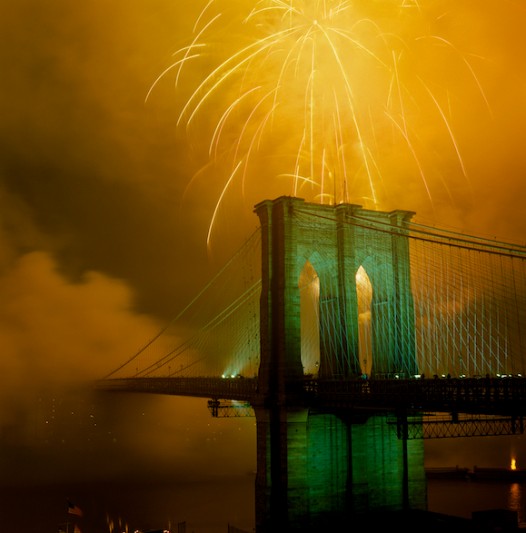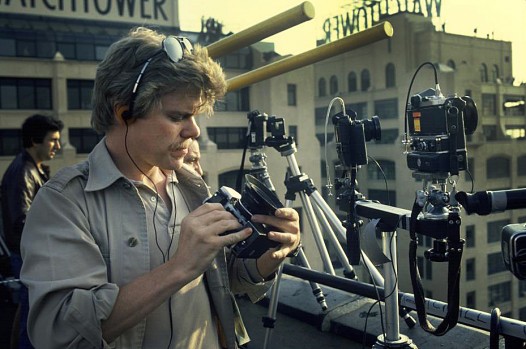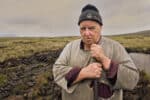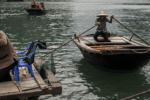I’m checking focus on a Nikon F in this picture. It was 1983, and I was about to shoot the 100th Anniversary of the Brooklyn Bridge from a rooftop in Brooklyn. There’s an F3 and an F2 on the twin cam platform, so I am basically out with the whole family. Poking into the pic on the right was the finder for my Hassy, which was fitted with an 150mm lens, and ultimately produced the picture you see below. I got the stache going on, and my Sony Walkman blasting out the traffic noise, and I’m just locking and taping things down, sighting cameras, and generally getting ready for the mayhem of of the biggest fireworks displays–ever.

Which was orchestrated by the redoubtable Grucci Family, the first family of fireworks. Based out on Long Island, this family has had explosives in its blood since 1850. In an early assignment for Discover Magazine, I was sent out to the island to shoot some pictures to support a story about the science of fireworks. It was like visiting a munitions depot.
Thank goodness for decent available light. No flash allowed near the warehouse, which was basically a large grenade with doors on it. (Indeed, the Grucci’s had a terrible, accidental explosion in 1983, which cost two family members their lives, and caused them to move the warehouse to a more secluded location.)
As evening approached, I coaxed mom and dad Grucci out into a field that contained barrels where they tested and exploded various rockets and the like. As an early experiment in flash photography, I put a Norman 200B low, into their faces, and another just in front of the barrel, gelled warm, hopefully lighting up their backsides like a firework blast. I think I got one frame that worked, and the magazine loved it. Kodachrome. One frame. No replays. No LCD. Had to wait for the mag to call and tell me they liked this kind of mildly strange portrait of a wonderful, elderly couple in front of something that was getting blown up.
But, around this time of year, in preparation for the coming 4th of July, I reprint a chapter from the LIFE Guide to Digital Photography, in which I wrote about hopefully most of the nuances and details of shooting fireworks.
Everybody loves to shoot fireworks. It has lots of connotations—holiday, patriotism, hot dogs, weekend, kids, family. Time to relax. Time to shoot some pictures.
Okay, make a checklist. Camera. Wide angle zoom. Telephoto zoom. Flash cards. Cable release. Spare camera battery. Tripod. Headlamp, and hand held flashlight. Watch with timer function. Black card. (More on that later.)
That’s pretty much the photo kit. What else to think of? Rain gear, both for cameras and you. You can get fancy rain gear designed for cameras and lenses, or just use plastic bags and baggies. Couple of bungee cords to keep the bags on the camera if the wind starts whipping about. Water and power bars—you’ll be out there a while. Bug repellent. Comfortable clothing and shoes. The car might be quite a ways away, and you’ll be walking a fair piece. Advil. (Advil is always on my equipment list.)
Anything to do beforehand? You bet. Scout the location. Best to know what you are getting into, where they shoot the fireworks from, what the background will be like. How big will the display be? How long will it go for? Most fireworks displays are well over in a half hour or less, and if you are stumbling around in the crowd looking for a spot and trying to setup in the dark, you’ll just be starting to make decent exposures as they light up the sky with the crescendo and say goodnight till next year.
That’s right, next year. Most big shoot ’em ups are yearly events. Argh, the pressure!
So scout. Get your spot. Get there early. I mean early. Like, be the first car in the parking lot. Pack a soft cooler sling bag, throw an icepack in there, and know that in that bag is your sustenance till maybe late at night. For jobs like this, my Ipod and earphones are a must. Maybe a collapsible chair, and a small waterproof tarp. Think your way into this. What could go wrong? It’s a photo shoot, so the answer to that is, just about everything. Try to ensure success by envisioning the shot and the potential problems in making the shot before you walk out the door.
Like, do you need a permit to put your tripod down? Did you have to call the town about this adventure? Most likely not, but in this post 911 world, photographers are often treated as being just this side of a recidivist offender, so it might be worth a phone call.
Okay, prepped and ready. Time to frame up the shot, which is a bit trickier than you might think. First off, when I shoot fireworks, I always get my frame, plus about 20%. I can always tighten up, but I want to give those fireworks room to play up there in the heavens. Frame too tight, you’ll have tracer lines of color going right out of the upper part of your picture, creating lines of interest that will pull your viewer’s eye right out with them.
So give them room to breathe and determine whether the shot is horizontal or vertical. Remember that most fireworks pix, if they are just of the explosions in the sky, are, at the end of the day, an exercise in color, nothing more. Even something as splashy as a pyrotechnic display needs context. So perhaps you can frame up with the object that is being celebrated, such as the Statue of Liberty. Or use the semi-silhouetted crowd as a foreground element. Or boats and bridges out in the water, with the water acting as a giant reflector board filled with color.
The variations that may occur with your framing are the reason to have at least a couple lenses with you. As mentioned above, two reasonable zooms, one wide and one telephoto, should do you fine.
Metering? Yikes, how do you meter a fast moving rocket moving through the black sky? The answer is, you don’t, really. This is a situation to shut off a bunch of the auto this and that on the camera, and go manual. Also, make sure to turn the flash off. Some cameras will read the darkness in in certain modes and activate that puppy. Ever see the opening of an Olympics, where thousands of people are using point and shoots, and their flashes are going off like crazy? Know what they’re lighting? The shoulder of the person in front of them. Fireworks, unless you are trying a radically different approach, are generally a no flash zone.
Okay, now set up manual. Fireworks are brighter than you might think, so you don’t need to open the lens really wide, which is a bit counter-intuitive, I know, ’cause it’s dark. But my experience with fireworks wide open is that you drain the color out of them. They’ll just register as a white streak. Be careful. You can over-expose fireworks quite easily.
F8 is a reasonable starting point. Some photogs I know go even lower on the aperture scale, down to f11 or even f16. Over time, you will find which settings work for you. (I used to take notes at the end of a fireworks job, just to keep myself tuned up for next year. No real need for that anymore, as the metadata tells you what works and what doesn’t.)
Set the shutter to bulb. This mode keeps the shutter open as long as the release button is pushed. But you are not physically pushing that button are you?! No! This is absolutely a job for a cable release. Nowadays, most cable releases are simply electric cables which jack into the camera and activate the shutter. When you punch the button on the cable release the shutter is at your command, and will stay open as long as you want. And, very significantly, the button you are pushing is not on the camera or the tripod. With lengthy exposures, even the slightest jiggle or vibration is the enemy.
This is important, because at f8, the shutter will be open for a while, meaning anywhere from four to 10-15 seconds. (Remember if you have a foreground element in the picture, such as a monument, you have to make sure that lit up monument is exposed properly. In many ways, that foreground object will determine the length of your exposure.)
Again, due to the brightness of fireworks, you can work at a reasonable or even low ISO. Something in the neighborhood of 100 or 200 will do fine. The faster your ISO, the shorter your shutter speeds, which will deprive you of recording those wonderful tracers of light into the sky.
Some shooters time the launch of the rockets and open their shutter accordingly, keeping it open for, say, 8-10 seconds, then closing down. This ensures that they will record the path of the pyrotechnic into the night sky, and it’s explosion. This is a fine approach. Give it a try.
Others use a black card. A black card is just that, a black card. Nothing mysterious or fancy. It can be a piece of black cardboard, or foam core board. Or it can just be an index card covered with black tape. (Be sure it is not shiny tape. That might pick up slivers of light and reflect it back into the lens. Use a matte black type of photo tape, often called gaffer tape.)
This way, you can keep your shutter open for very lengthy periods of time, and record multiple starbursts. You open the shutter, and shoot one explosion, then cover the lens with the card, and wait for the next. You can experiment with this trick, and produce really terrific results by layering multiple fireworks into one picture.
(Also, say, you have the Brooklyn Bridge as an architectural element in the foreground, and the proper exposure for it is f8 at 10 seconds. This limits your fireworks shooting range, right? Gotta get the bridge right, so the exposure is a done deal. But, with the black card, if you are quick enough, you can uncover just the upper portion of the sky, while blocking the area of the lens which is recording the bridge. This is dicey. You have to move the card quickly, hovering it around where the bridge ends and the sky begins. If you have ever made a black and white print in the darkroom, think of this as burning and dodging right at the camera lens. Can’t keep the card static or it will create a hard line of obvious exposure change. It has to hover, quickly jiggling around that sky bridge borderline. If you pull this off right, you can keep your lens open for several batches of fireworks, extending over 20-30 seconds, filling the sky with color. But—this is an experiment! Back yourself up by shooting some “straight” frames.)
At the beginnings of the digital rage, this technique was a bit problematic, because seriously lengthy exposures produced a lot of digital noise. The longer the shutter is open, the longer the chip is “on” building up heat with every passing second. That sensor heat would really fray away at the quality of the digital file you would be trying to produce. Bad news. Long time exposures were the Achilles heel of early digital cameras. Predictably, advances in digital camera technology have smoothed out a lot of those problems, but it is wise to experiment with your particular model and see what its’ tolerances are. As you might suspect, the higher end models handle long exposure well, while the more basic cameras will have limitations. Get to know what your camera is capable of. In many current cameras, you can turn on a function called “long exposure noise reduction.” Hugely helpful.
Other bits and pieces: Don’t shoot all night long at one exposure. (If you are on bulb, you definitely won’t anyway.) But this is an occasion for bracketing, and shooting as many frames as possible. Also, shoot right away when they start! Fireworks displays can build up a lot of smoke over a series of explosions, and if you are smack in the wind pattern that blows that smoke towards your lens, you can end up thinking you’re shooting a war zone. So shoot immediately, and fast.
Have a wonderful, safe 4th of July, everybody! More tk…



















Always enjoy the glimpses back on your years of shooting..what a ride! Thanks ~ happy summer and happy shooting
Hi Joe,
Slan Abhaile – hello from Ireland….Fantastic Stache! That’s gotta put Magnum PI to shame 🙂 Thanks for your posts I check your blog all the time waiting for one of your amazing inspirational stories. Can i just say that your book Sketching Light was just brilliant and really inspired me to take up photography full time, recently. Your work, your writing and your generosity with your experiences and technique have been more than an encouragement, for that I thank you sincerely. Just adored those shots from China by the way, truly magnificent…the client must have been delighted. Have a great day Joe,
Warmest Regards,
Jude
Now the important question, what type of music did you listen to while setting up the cameras?
I was 9 days old when that first photo was taken… I turn 30 next week. You’ve inspired me more than any other photographer.
I’ve been trying to find every fireworks display I can in an effort to get dialed in for an event later in the summer. The Pyrotechnics Guild International annual convention is happening in my paper’s coverage area and the advance descriptions are rather intriguing.
The PGI folks promise me that one member intends to build a 24″ shell – the Grucci folks appear to be holding 8″ shells in the photo – that will go 5000″ high with a display 3000″ across. I’m thinking that if I can get my hands on one of those 8mm fisheye lenses I may have something… Otherwise I’ll just go with what I’ve got.
I’m with Hobby… I think Matt Damon should star in a film adaptation of your glorious career. Only, I think I’m being more serious/less sarcastic than DH… 😉
Also, great post, as always!
Joe,
You forgot to mention the cool aviator sunglasses. Guess you used them at night. You probably had a hurting back hauling an F, an motorized F2 and an F3 with a MD, as well as the Hassy with a long lens. Great tips. I loved the images and story on the Grucci’s. All that gunpowder – not the time to fry a flash or have it explode.
Have fun and be safe!
Bill Bogle, Jr.
Having been mistaken for Moose the other day… with that moustache in full flight, and a little bit of extra styling, I can see some distinct possibilities.
I’m liking the Matt Damon movie idea too – seriously. The McNally Identity.
All the best,
Simon
Aah now I get it, you are born as a light master Joe.
Always a pleasure to read about what you have done in the past. I hope you will continue to write until the end of days.
Interesting. I shot fireworks for the paper as Joe described. Used a tripod. And shot 400 speed film at f 11-16. Used the bulb setting and opened shutter from 1 to 4 seconds. Also had to find little kids that were seeing the fireworks for the first time. Tried to leave early as there was traffic. Had to get the film processed for the paper.
Happy 4th to you Joe!
One quibble. Long exposure noise reduction (in Nikons: don’t know Canon) keeps the camera busy for the same amount of time as the actual exposure. So you’re not going to be able to take another shot until that time has passed. 30 second exposure, wait another 30 seconds until you can take another. You automatically lose half the shooting time.
Do your noise reduction in post. LR and some of the plug-ins are pretty good at it.
You can also merge images later, in post. Use “lighten” blend mode for your layers in PS and mask out the bridge if you need to. I’ll open the shutter, wait for a few bursts, close it, open it, wait for a few more, and so on.
Good tip, Glenn…you’re right, you lengthen your time with in camera noise reduction….
Fun post, but it was seriously overpowered by that mustache!!
Great stuff Joe! I live in Calgary, Alberta, Canada and came to your One Light Two Light seminar which I thoroughly enjoyed. I brought my daughter and coerced her up on the stage where you took her picture as she jumped in the air. I’m sure I completely embarrassed her!
I love shooting fireworks. Have even done it using a 4X5 view camera. Keeps a fella busy! If you ever get the chance to come back here, perhaps try to make it during Stampede Week (actually 10 days long). The Calgary Stampede puts on a fireworks display every night during the Greatest Outdoor Show On Earth, so you can get dialled in and really get some great shots!
Congratulations Joe! Impressionant colors and texture of images. Thanks Glenn too for his aportation.
What’s up to all, how is the whole thing, I think every one is getting more from this web site, and your views are good designed for new visitors.
I’m going to test out that black card trick today. Thank you for the great tips!
Words from the boss himself, thanks for taking time to share this huge imformation.
Ahhhh that made me want to pull my old film bodies down off the shelf 🙂
But who took that excellent photo of YOU?